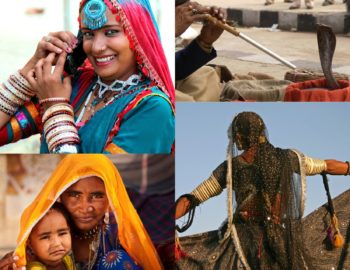Rajasthan’s Kalbeliya Gypsies Posted by Nicole Herbert Dean on Sep 24, 2021 in Culture, History, Travel & Geography
Rajasthan’s Thar desert is known for its scorching जलानेवाला sand and rugged बीहड़ terrain filled with snakes and other venomous creatures. This is where the Kalbeliya Gypsies कंजर जाति choose to live.
Kalbeliya is from the word ‘kal’ meaning death मौत. The word Kalbeliya connotes victory विजय over poisonous snakes and death.
Snake charmers, Shepherds and Healers
The Kalbeliya are a tribe of nomadic घुमंतू gypsies inhabiting the outskirts of Rajasthan’s cities, Pushkar, Ajmer, and Udaipur. They are snake charmers सपेरे, snake catchers, and venom traders. Some, work as healers चिकित्सकों, drawing from Tantric philosophy.
History and Mythology
A search for their history इतिहास, reveals they follow Guru Kanipa, the 12th disciple शिष्य of Guru Goraknath, the founder of the Nath traditions. According to legend दंतकथा, the Hindi god Shiva offered a bowl containing all the poisonज़हर in the universe to Kanipa. He drank it all at once and survived बच गई . Upon seeing this, Shiva, promised Kanipa he would be taken care of by the universe.
Dress
The Kalbeliya wear colorful skirts रंगीन स्कर्ट and tunics heavily embroidered भारी कशीदाकारी with mirror work along with heavy silver jewelry आभूषण . The men usually wear long shirts over the dhoti, which are loose-fitting ballooning pants. Others wear pants adopting westernization.
Homes
Since they travel यात्रा and are on the move constantly, the Kalbeliya live in tents तम्बू that protect them from the harsh कठोर elements. The tents are rustic देहाती and made of tarps and other fabric fastened with sticks from nearby desert रेगिस्तान trees. These tents are set up in camps शिविर called ‘deras’. Some live in regular concrete बजरी or mud houses if they choose to be sedentary.
Work for Food
Since they live off the land, the Kalbeliya chop काटना and gather wood. They cover the piles of wood लकड़ी के ढेर with sand and cloth and burn and turn them into coal कोयला which they sell in markets.
Former Kalbeliyas would hunt शिकार deer and blue antelope but due to the government ban प्रतिबंध since 1972 they are mostly vegetarian. They do gather and grow इकट्ठा करो और बढ़ो as much as they can, given the desert conditions. They seem to be fearless निडर in their pursuits – smoking bees out of hives with eucalyptus cigarettes बीड़ी in order to capture honey.
Their work as snake charmers and catchers provides them with the skills they need. They are able to cure poisonous snake bites and other diseases, with herbs and plant जड़ी बूटी और पौधे remedies due to their knowledge of the flora and fauna that surrounds them. They trade venom which is used as an ayurvedic remedy निदान to cure sight issues.
Increasingly over the years realizing the lucrative लाभप्रद nature of tourism, they are into performance art प्रदर्शन कला and work as entertainers, playing instruments, and dancing at local tourist spots.
Usual and Unusual Practice
What sets the Kalbeliya apart from other Hindu communities समुदाय is that they bury their dead instead of cremating. Their funerals are celebrated with music and dancing.
Also, they honor the dowry system, but with a twist -the bridegroom has to produce dowry and his father pays for the wedding.
The Kalbeliyas also wish for daughters, unlike many communities. They realize that dancing is a lucrative लाभप्रद activity.
Music and Dance
Currently, many Kalbeliya choose the performing arts and perform at tourist spots, hotels and parties. They play instruments such as the ‘been’, ‘dulfi,’ and ‘dholak’, accompanying their colorfully clad dancers. Their dances imitate नकल करना nature and spontaneously tell stories through songs. . In 2010 the UNESCO recognized स्वीकृत the Kalbeliya songs are part of their Intangible Cultural Heritage List.

Build vocabulary, practice pronunciation, and more with Transparent Language Online. Available anytime, anywhere, on any device.




